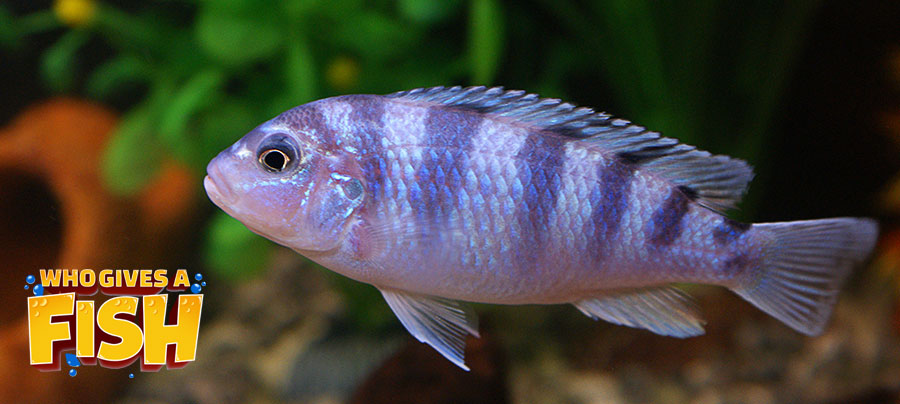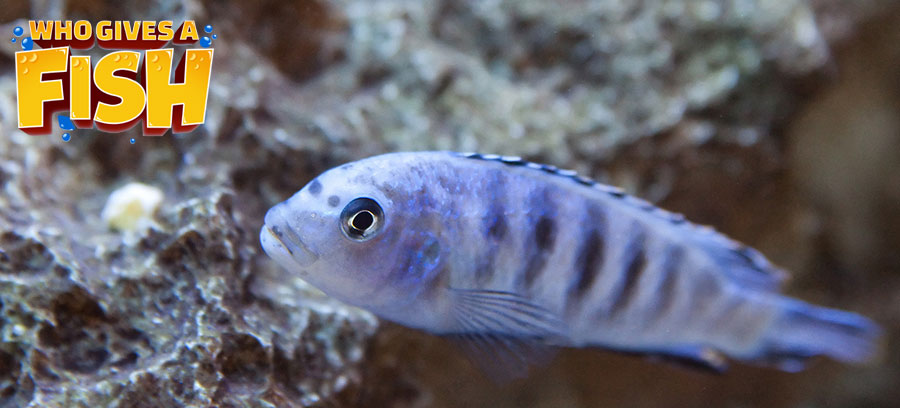Kenyi Cichlid
The Kenyi Cichlid, Maylandia lombardoi, is a wonderful, bright blue Cichlid that displays vetical bars across its body and males will change to a bright orange color when maturing. An aggressive Mbuna from Lake Malawi, this Cichlid can grow up to 6 inches (15.2 cm) in length and is a prolific breeder when water conditions are optimal.
- Experience Level: Intermediate
- Hardiness: Moderate
- Minimum Tank Size: 50 gal (190 L)
- Maximum Size: 6 in. (15.2cm)
- Temperament: Aggressive
- Temperature: 76 – 82° F (24.4 – 27.8° C)
- pH Range: 7.8 – 8.6
- Water Hardness: 10 – 15 dGH
- Diet: Omnivore
Table of Contents
Introduction
Aquarium Setup
Difficulty
Feeding
Breeding and Social
The Kenyi Cichlid is unique throughout the Mbuna group in that its coloration variation between the sexes and patterns are not found in other Cichlids. The Kenyi males are yellow and females are blue whereas other Mbuna are the opposite, with females usually being the yellow/orange colors.
This fish certainly is not for beginners due to the aggression they can possess. Any smaller fish in your tank will be attacked and chased relentlessly until killed. They will also kill their own, often picking on the smallest of the group.
They are very easy to breed and the entire breeding process of this particular Cichlid is very entertaining. Breeding is discussed in more detail below.
Aquarium Setup
Getting your water parameters correct for the Kenyi is essential to it’s health and longevity. Lake Malawi has high concentrations of minerals and is this Cichlid requires harder water than usual. It is not recommended for brackish tanks though.
You will be able to accommodate a group of 5 to 6 Kenyi Cichlids in a 50 gallon tank, provided you keep them on their own. Any futher additions of either the Kenyi or other fish will require a much bigger tank in order to provide more territory. They are very territorial and will attack other fish smaller than themselves and especially around their burrows.
Adding crushed coral and oyster shells to your sump or canister filter will help you in raising the pH. Instead of adding these substrates to your main tanks substrate, where it is impossible to control once mixed into gravel, keeping different amounts for adjusting levels, can be kept in a stocking or similar filter bag. This gives you more control over pH changing substrates in your system. A filter bag is easy to empty and refill with new shell and coral.
It is very important to monitor your ammonia levels as the pH is higher, and spikes in levels can become toxic quickly.
You will need to fasten all rock work and strongly anchor down any plants as the Kenyi Cichlid will burrow and rearrange everything in your tank if it has the chance. Small to medium sized gravel is preferred and makes burrowing easier for them.
Black substrate will really make their colors pop under good lighting.
Kenyi Cichlid Aquarium Guide
- Minimum Tank Size: 50 gal (190 L)
- pH Range: 7.8 – 8.6
- Water Hardness: 10 – 15 dGH
- Temperature: 76 – 82° F (24.4 – 27.8° C)
- Lighting: Moderate to strong lighting
- Substrate: Small to medium sized gravel
- Brackish: No
- Water Flow: Low to moderate
- Tank Region: Mid to bottom
Difficulty
It would be best for you to understand aggression management and to watch as many videos on Mbuna Cichlids as possible. These fish will do well in a group of their own, provided you give them enough space, but any sick, small or weak fish will be hunted down and killed.
The Electric Yellow Cichlids are great tankmates, but it is important that they are bigger than the Kenyi, otherwise they will likely be eaten. Other species that are not Cichlids will also be devoured if small enough.
Be careful not to feed them too much protein and fats or to let your water get below excellent quality as these can cause Malawi bloat and eventually kill your Kenyi.
Feeding
The Kenyi Cichlid is a ferocious eater and will graze all day on algae in your tank. This can be useful as it removed the need for cleaner fish. They will do best on Cichlid specific pellets and flake food, but occasionally live brine shrimp can be offered as a treat.
To help ensure the fish is healthy and as a side effect, make their colors really bright, you should supplement their diet with spirulina flakes, or partly cooked foods such as spinach, peas and other dark leafy greens. Ensure these are soft enough for the fish to digest. If you cannot break the vegetable down in your fingers, then it is too hard.
Feed them several small servings per day to aid in aggression mitigation and maintain water parameters.
Kenyi Cichlid Feeding Guide
- Diet: Omnivore
- Frequency: Several small feedings per day
- Pellet Foods: Cichlid specific pellet foods
- Flake Foods: Cichlid specific flake foods
- Live Foods: Occasionally
- Meat Foods: Occasionally, not more than once per week
- Vegetable Foods: Majority of diet
A great video of from James Newhauser shows the Kenyi Cichlids breeding
Breeding
Male Kenyi Cichlids will be blue and look just like the females when young. Once a group of Kenyi establish themselves, 1 to 2 of them (depending on the size of the group) will begin to change into a bright orange and yellow color. They will also produce several golden eggspots on their anal fin that they use to trick the female.
A pair will chase each other around the tank and swim around in circles, as if to chase each other. These circles can get smaller and smaller until the fish are swimming so quickly that they become a blur.
Once they have chosen their flat rock or surface, the female will lay her eggs and quickly swim back around to collect them in her mouth. The male tricks the female into thinking the eggspots on his anal fin are eggs she has just laid, and when she goes to pick them up, he releases his milt. This sucked into the fishes mouth and fertilizes the eggs. This process will happen until she has collected approximately 50 eggs in her mouth.
The female will be exhausted and will not eat for the entire 18-21 days that she holds the eggs in her mouth. Being a mouthbrooder, she should be removed from the main tank and place into a separate tank with the same water from the main tank.
The young fry will begin to freely swim in and out of her mouth, and provided she does not panic and eat them, many will survive. You should begin to feed them cyclopeeze and very finely crushed Cichlid flake food. Leaving these fry in the main tank will see most of them eaten and it is common for a weak female to be killed, so ensure she is well fed and back up to strength before reintroducing her to the main tank.
Social
While not a community fish, they can be kept with other Mbuna if the tank is large enough for aggression management. The ideal setup would be for 5 to 6 females and one male. Multiple males have been kept together, but if the tank is not big enough, they will try to kill each other.



